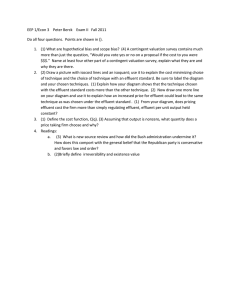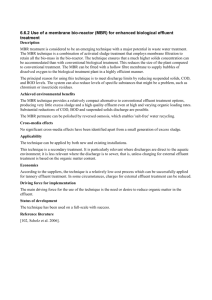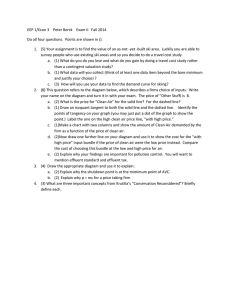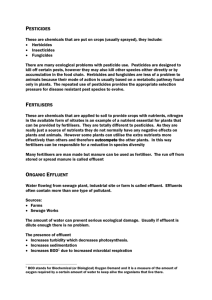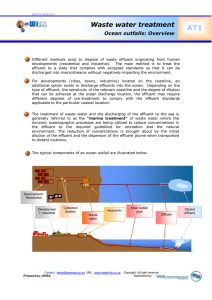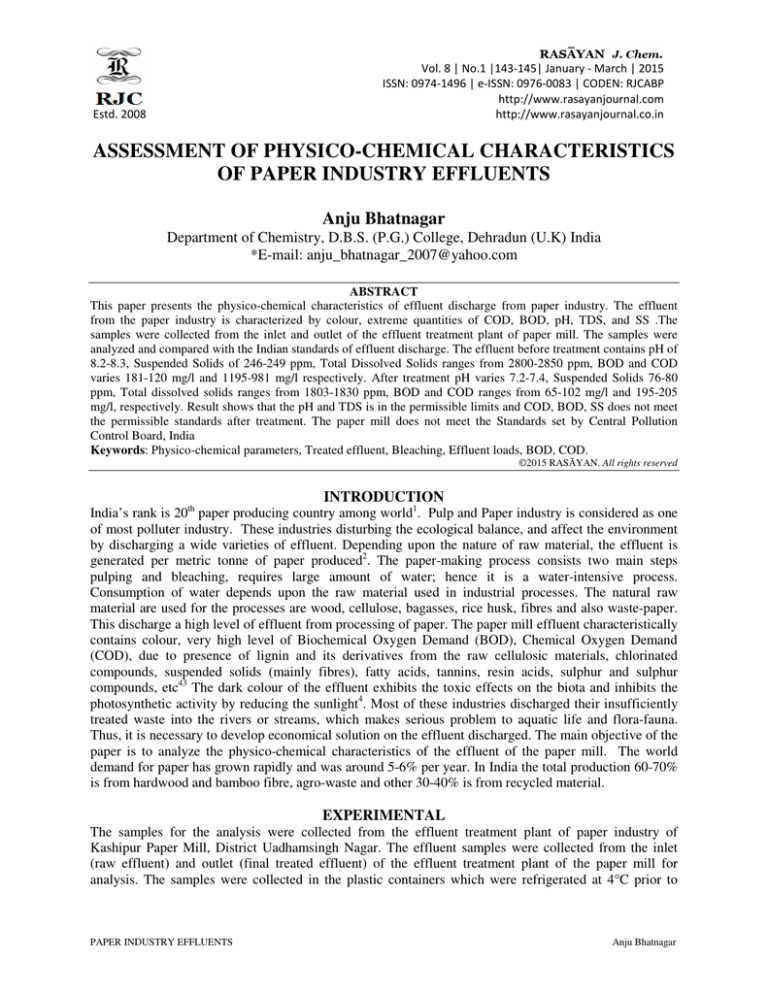
Vol. 8 | No.1 |143-145| January - March | 2015
ISSN: 0974-1496 | e-ISSN: 0976-0083 | CODEN: RJCABP
http://www.rasayanjournal.com
http://www.rasayanjournal.co.in
Estd. 2008
ASSESSMENT OF PHYSICO-CHEMICAL CHARACTERISTICS
OF PAPER INDUSTRY EFFLUENTS
Anju Bhatnagar
Department of Chemistry, D.B.S. (P.G.) College, Dehradun (U.K) India
*E-mail: anju_bhatnagar_2007@yahoo.com
ABSTRACT
This paper presents the physico-chemical characteristics of effluent discharge from paper industry. The effluent
from the paper industry is characterized by colour, extreme quantities of COD, BOD, pH, TDS, and SS .The
samples were collected from the inlet and outlet of the effluent treatment plant of paper mill. The samples were
analyzed and compared with the Indian standards of effluent discharge. The effluent before treatment contains pH of
8.2-8.3, Suspended Solids of 246-249 ppm, Total Dissolved Solids ranges from 2800-2850 ppm, BOD and COD
varies 181-120 mg/l and 1195-981 mg/l respectively. After treatment pH varies 7.2-7.4, Suspended Solids 76-80
ppm, Total dissolved solids ranges from 1803-1830 ppm, BOD and COD ranges from 65-102 mg/l and 195-205
mg/l, respectively. Result shows that the pH and TDS is in the permissible limits and COD, BOD, SS does not meet
the permissible standards after treatment. The paper mill does not meet the Standards set by Central Pollution
Control Board, India
Keywords: Physico-chemical parameters, Treated effluent, Bleaching, Effluent loads, BOD, COD.
©2015 RASĀYAN. All rights reserved
INTRODUCTION
th
India’s rank is 20 paper producing country among world1. Pulp and Paper industry is considered as one
of most polluter industry. These industries disturbing the ecological balance, and affect the environment
by discharging a wide varieties of effluent. Depending upon the nature of raw material, the effluent is
generated per metric tonne of paper produced2. The paper-making process consists two main steps
pulping and bleaching, requires large amount of water; hence it is a water-intensive process.
Consumption of water depends upon the raw material used in industrial processes. The natural raw
material are used for the processes are wood, cellulose, bagasses, rice husk, fibres and also waste-paper.
This discharge a high level of effluent from processing of paper. The paper mill effluent characteristically
contains colour, very high level of Biochemical Oxygen Demand (BOD), Chemical Oxygen Demand
(COD), due to presence of lignin and its derivatives from the raw cellulosic materials, chlorinated
compounds, suspended solids (mainly fibres), fatty acids, tannins, resin acids, sulphur and sulphur
compounds, etc43 The dark colour of the effluent exhibits the toxic effects on the biota and inhibits the
photosynthetic activity by reducing the sunlight4. Most of these industries discharged their insufficiently
treated waste into the rivers or streams, which makes serious problem to aquatic life and flora-fauna.
Thus, it is necessary to develop economical solution on the effluent discharged. The main objective of the
paper is to analyze the physico-chemical characteristics of the effluent of the paper mill. The world
demand for paper has grown rapidly and was around 5-6% per year. In India the total production 60-70%
is from hardwood and bamboo fibre, agro-waste and other 30-40% is from recycled material.
EXPERIMENTAL
The samples for the analysis were collected from the effluent treatment plant of paper industry of
Kashipur Paper Mill, District Uadhamsingh Nagar. The effluent samples were collected from the inlet
(raw effluent) and outlet (final treated effluent) of the effluent treatment plant of the paper mill for
analysis. The samples were collected in the plastic containers which were refrigerated at 4°C prior to
PAPER INDUSTRY EFFLUENTS
Anju Bhatnagar
Vol. 8 | No.1 |143-145 | January - March | 2015
further treatment. The samples were analyzed using standard methods of analysis of water and waste
water5. Effluents samples collected from paper mills were analyzed for the required parameters in order to
evaluate the pollution load of water streams in which they are thrown6. Physiochemical analysis of
effluent, the samples collected from the paper industry was brought for the physiochemical analysis in
laboratory of Pulp and Paper Department, Forest Research Institute, Dehradun .The pH was measured by
pH meter. For colour measurements standard solution of 500 pt.co (ppm) units was prepared to dissolve
the 1.246g of potassium hexachloroplatinate and 1g of cobaltous chloride in 100 ml of conc. HCl and
make up to 1 litre with distilled water. 10 ppm to 100ppm standard colour solution is prepared by diluting
the solution is 500 ppm stock solution. Unknown colour is matched with standard solution. The COD and
BOD5 were determined titrimetrically, suspended solids and total dissolved solid was measured by using
WHATMAN filter paper.
RESULTS AND DISCUSSION
The paper mill produces variety of writing and printing paper using bagasse as raw material. The average
production of paper in the mill is around 50,000 tonne per year to produce huge different varieties of
paper. The effluent generated from the paper mill consists of white water from stock preparation, paper
machine and from the bleach section etc .The effluent for analysis is collected from the inlet, which is
more polluted and from the outlet, that after treatment from the ETP. The results of monthly analysis of
pH, colour, COD, BOD, TDS, SS are analyzed after treatment and compared with the standard values
(Table-1).
Table -1: Parameters Raw and after treatment of effluent of paper mill
S. No.
Parameters
Raw Water
1
2
3
4
5
6
PH
Colour (pt.co units)
Total Dissolved Solids (ppm)
Suspended Solids(ppm)
COD (mg/L)
BOD (mg/L)
8.2-8.3
54-56
2800-2850
246-249
1195-981
181-120
Final Outlet of water treatment plant
in a paper mill
7.2-7.4
228-229
1803-1830
76-80
195-205
65-102
pH
The hydrogen-ion concentration is an important parameter to check the quality of effluent discharge from
the plant or to a measure of acidity and basicity of an aqueous solution. Discharges water from pulping
and bleaching plant has both acidic and alkaline effluents. The pH of the influent (raw effluent) was
measured to be 8.1-8.2 which is alkaline as reported7 compared to 7.2-7.4 with treated effluent. Low
value of pH is due to the metabolism of fungus, micro flora and activities of microbial population8.
Colour
The colour is usually the first contaminant to be recognized in effluents that affects the aesthetics, water
transparency and gas solubility of water bodies9. This colour is due the high concentration of lignin
content in the outlet sample. Colour derived from lignin is an indicator of the presence of potentially
inhibitory compounds and in addition, may have direct inhibitory effects on some of the lower organisms
in the food chain. The colour of the effluent typically depends upon the different industrial processes. The
final outlet of the water treatment plant has the value of 228-229 pt.co units.
Suspended Solids
The un-dissolved matter present in water or waste water is usually referred as suspended solids.
Suspended solids reduce the photo synthesis activities of water plants by smothering benthic organism.
The concentration of suspended solids measured from inlet of ETP ranges from 246ppm-249ppm after
treatment the concentration of suspended solids is ranges from 76 ppm-80 ppm respectively. Suspended
solids from the effluent reduce slightly due to the presence of fibres in the effluent.
PAPER INDUSTRY EFFLUENTS
144
Anju Bhatnagar
Vol. 8 | No.1 |143-145 | January - March | 2015
Total Dissolved Solids
The total dissolved solids concentration varied from inlet 2800-2870 whereas from treated effluent varied
from 1803-1830 ppm respectively. The value shows The TDS may increase salinity of the water and thus
may render it unfit for irrigation and drinking purposes. TDS are in permissible limit as compared with
Indian standards.
BOD and COD
Biological Oxygen Demand is the measure of the oxygen required by microorganisms whilst breaking
down organic matter. BOD measures the organic loading of streams and thereby quantifies the dissolved
oxygen levels and Chemical Oxygen Demand is the measure of amount of oxygen required to breakdown
both organic and inorganic matters. The BOD and COD levels of influent effluent varied from 181-210
mg/l and 1195-981 mg/l respectively. Whereas the BOD and COD levels of effluent varied from 65-102
mg/l and 195-205 mg/l respectively. The levels of BOD and COD is reduced to certain extent by
biological treatment process for which the effluent is treated which consists of equalization, primary
clariflocculator , aeration tank and the secondary clariflocculator. Biological treatment process results in
oxidation of organic matter, which provides energy for microbial metabolic process6. The pH and TDS of
the effluent is within the Indian standard limits. And also within the permissible limit set by Central
Pollution Control Board, India to discharge for irrigation. Whereas, the other parameters such as SS, COD
and BOD are not within the limits of Indian standard. High COD levels indicate the toxic state of the
waste water along with the presence of biologically resistant organic substances10. The high BOD and low
oxygen content of effluent will affect survival of gill breathing animals of the receiving water body.11
CONCLUSION
The paper mill is growing fast and produces different varieties of paper. The physico-chemical
characteristics of effluent from this mill revealed that the effluent is light brown in colour, pH shows
alkaline nature of the effluent, SS, BOD, COD are the parameters from the treated effluent is high in
concentrations compared to Indian standards.
ACKNOWLEDGEMENTS
Authors are thankful to Director, Forest Research Institute, Dehradun for providing the lab facilities.
REFERENCES
1.
2.
3.
4.
5.
6.
7.
8.
9.
10.
11.
P.Malaviya, V.S.Rathore, Journal of Environmental Biology,28(2),219(2007)
M.Ugurulu, M.H.Karaoglu, I.Kula, Polish J. Of Environ. Stud. ,15( 4) ,647(2006)
M.Ali, and T.R. Sreekrishnan, A. Review Adv. Environ. Res., 5,175(2001).
N.K.Swamy, P.Singh, I.P.Sarethy, Rasayan Journal Chemistry, 4(2), 452(2011).
A.E.Greenberg, A.D.Eaton, Standard methods for the examination of water and effluent, 20th edition
(American Public Health Association, American water works association, water environment
federation, (1998).
R.Maheshwari, B.Rani, A.Saxena. M. Prasad., U.Singh., Journal of Advanced Scientific Research,
3(1), 82(2012).
K.K.Deepali, R.Gangwar, B.D. Joshi, Indian Journal of Environmental Sciences, 3(2), 49 (2009).
N.Kirkpatric, A Handbook on “Pulp and Paper Industries”, Pollution Prevention and Abatement.
395-399.(1998)
W.Yuxing, Y,Jain, Water Research, 33(16), 3512(1999)
S.K.Dutta, Journal of Environment Pollution, 5, 13(1999).
C.C.Sawyer, P.L.McCArty., “Chemistry for Environmental Engineers”. McGraw Hill, New York,
331-514, (1978).
[RJC-1216/2015]
PAPER INDUSTRY EFFLUENTS
145
Anju Bhatnagar

